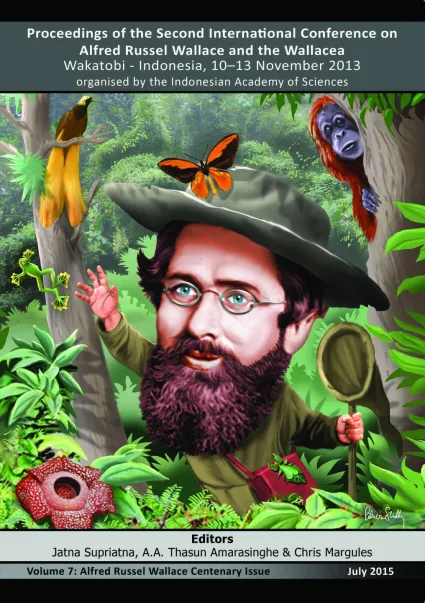

v7i3.188
Wallace Centenary Issue | Volume 7 | Number 3 | 2015
Major Article
ISSN: 1800-427X (print)
eISSN: 1800-427X (online)
Alfred Russel Wallace Centenary Issue
DOI:10.47605/tapro.v7i3.188
Proceedings of the Second International Conference on Alfred Russel Wallace and the Wallacea
Organised by the Indonesian Academy of Sciences
Wakatobi - Indonesia (10–13 November 2013)
J. Supriatna, A.A.T. Amarasinghe, and C. Margules (Editors)
Published date: 30 July 2015
Pp. 157–169, Pls. 8–9.
EX-SITU CONSERVATION OF PLANT SPECIES IN INDONESIA WITH A FOCUS ON WALLACEA
Ismayadi Samsoedin*, Kuswata Kartawinata & Ugi Sugiarti
*Corresponding author. E-mail: isamsoedin@yahoo.com
Abstract
Biodiversity conservation is a national priority in Indonesia as a part of the implementation of sustainable development. Both in-situ and ex-situ conservation should be practised so as to make certain that biodiversity can be conserved, studied and sustainably utilized. The Indonesian Institute of Sciences (LIPI) and Ministry of Environment & Forestry (KLHK) are responsible for the conservation of biodiversity as the scientific authority and management authority, respectively. Several pathways of ex-situ conservation may be undertaken through restoration of degraded ecosystems, improvement of fallows, development of arboreta, botanical gardens (BG), city parks, and biodiversity parks, planting road-side trees and rehabilitation of degraded lands using indigenous species, particularly rare and protected species. Ex-situ conservation of plant species through the above-mentioned pathways will become increasingly important, as in-situ conservation is facing many constraints. Several sites in Wallacea have been designated as ex-situ conservation areas such as the Toraut Arboretum at Bogani Nani Warta Bone in North Sulawesi [proposed by the Wallacea Development Institute (WDI), and established by local government in 1994], and five new botanical gardens: Massenrempulu, Jompie, Minahasa, Pucak, and Kendari. This paper describes the roles of the floristic conservation pathways and outlines the development of the above-mentioned arboretum and botanical gardens as case examples.
Key words : arboretum, biodiversity parks, botanical gardens, indigenous, city parks, Sulawesi
eISSN: 1800-427X (online)
Alfred Russel Wallace Centenary Issue
DOI:10.47605/tapro.v7i3.188
Proceedings of the Second International Conference on Alfred Russel Wallace and the Wallacea
Organised by the Indonesian Academy of Sciences
Wakatobi - Indonesia (10–13 November 2013)
J. Supriatna, A.A.T. Amarasinghe, and C. Margules (Editors)
Published date: 30 July 2015
Pp. 157–169, Pls. 8–9.
EX-SITU CONSERVATION OF PLANT SPECIES IN INDONESIA WITH A FOCUS ON WALLACEA
Ismayadi Samsoedin*, Kuswata Kartawinata & Ugi Sugiarti
*Corresponding author. E-mail: isamsoedin@yahoo.com
Abstract
Biodiversity conservation is a national priority in Indonesia as a part of the implementation of sustainable development. Both in-situ and ex-situ conservation should be practised so as to make certain that biodiversity can be conserved, studied and sustainably utilized. The Indonesian Institute of Sciences (LIPI) and Ministry of Environment & Forestry (KLHK) are responsible for the conservation of biodiversity as the scientific authority and management authority, respectively. Several pathways of ex-situ conservation may be undertaken through restoration of degraded ecosystems, improvement of fallows, development of arboreta, botanical gardens (BG), city parks, and biodiversity parks, planting road-side trees and rehabilitation of degraded lands using indigenous species, particularly rare and protected species. Ex-situ conservation of plant species through the above-mentioned pathways will become increasingly important, as in-situ conservation is facing many constraints. Several sites in Wallacea have been designated as ex-situ conservation areas such as the Toraut Arboretum at Bogani Nani Warta Bone in North Sulawesi [proposed by the Wallacea Development Institute (WDI), and established by local government in 1994], and five new botanical gardens: Massenrempulu, Jompie, Minahasa, Pucak, and Kendari. This paper describes the roles of the floristic conservation pathways and outlines the development of the above-mentioned arboretum and botanical gardens as case examples.
Key words : arboretum, biodiversity parks, botanical gardens, indigenous, city parks, Sulawesi
- List of Articles & Contents





